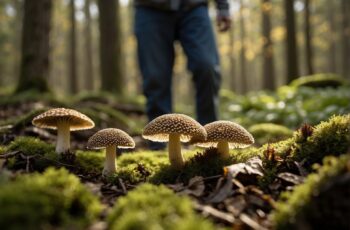Venturing into the woods and foraging for wild mushrooms can be an exhilarating experience for the avid outdoors enthusiast. However, if you don’t have the time to trek into the forest or the certainty to distinguish between edible and toxic varieties, finding a reliable source to purchase wild mushrooms is key. Whether for their unique flavors, healthful properties, or the rustic touch they add to a meal, wild mushrooms are a sought-after delicacy, and you can find them without having to don your boots and foraging basket.
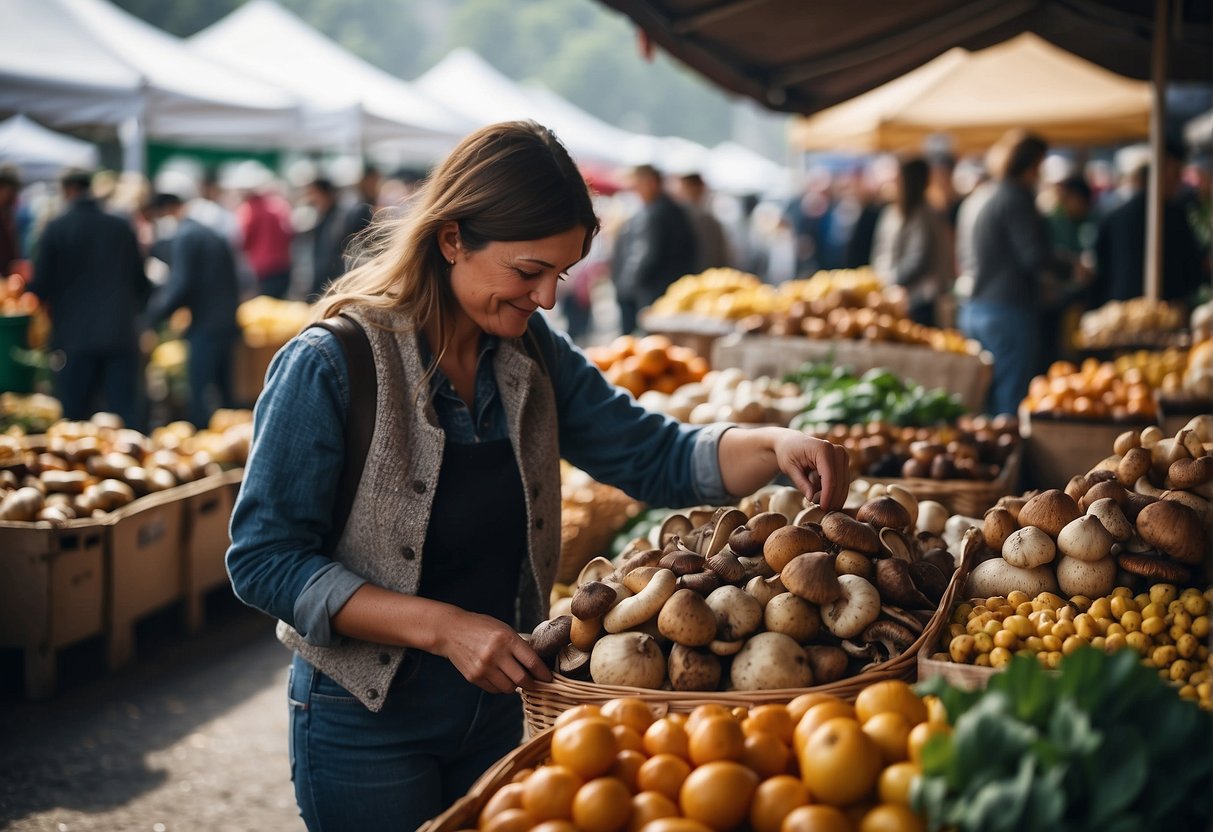
As you start your search for wild mushrooms, consider the variety of options available to you. From speciality online retailers, like Real Mushrooms, that provide a wide array of 100% pure, organic mushroom supplements to storefronts like D’Artagnan, where you can find fresh wild mushrooms known for their quality and gourmet appeal. These outlets cater to those who take their cooking seriously and are looking for the kind of flavors that only wild, foraged mushrooms can provide.
Knowing where to find wild mushrooms brings you closer to the natural world, and allows you to bring a piece of the untamed forest right to your kitchen. Whether you’re cooking up a storm or seeking the health benefits of mushrooms, finding the right type of wild, edible mushrooms is essential, and with today’s resources, it is easier than ever. Preparation is simple: once acquired, clean your mushrooms gently with a brush or damp cloth, cook as desired, and indulge in the rich earthy flavors of nature’s hidden culinary gems.
Identifying Wild Mushrooms
Before you embark on a foraging adventure for wild mushrooms, it’s paramount that you can accurately identify what you’re picking. Safety should always come first, and knowing the difference between a delightful morel and a toxic lookalike could save your life.
Safety Tips for Foraging
When you’re out in the woods searching for wild mushrooms, always go with an experienced forager. These individuals have years of knowledge and can teach you how to spot the safe varieties. Remember:
- Never eat a mushroom unless you’re 100% certain of its identity.
- Carry a field guide for mushrooms to reference.
- Avoid places that may be contaminated with pesticides or other chemicals.
Popular Edible Wild Mushrooms
For many, the morel is the holy grail of wild mushrooms, prized for its unique honeycomb appearance and rich flavor. Chanterelles are also sought after for their fruity aroma and delicate taste. Here’s a brief overview:
- Morels: Sponge-like cap, hollow stem, grows in the spring.
- Chanterelles: Trumpet-shaped, wavy edges, found near hardwood trees in summer and fall.
Avoiding Poisonous Varieties
Each year, poisonous mushrooms cause numerous illnesses and, in severe cases, fatalities. To stay safe:
- Steer clear of mushrooms with white gills, a skirt or ring on the stem, and a bulbous or sack-like base.
- Beware of false morels, which mimic true morels but can be deadly.
- When in doubt, leave the mushroom where you found it.
Best Times and Places to Buy Wild Mushrooms
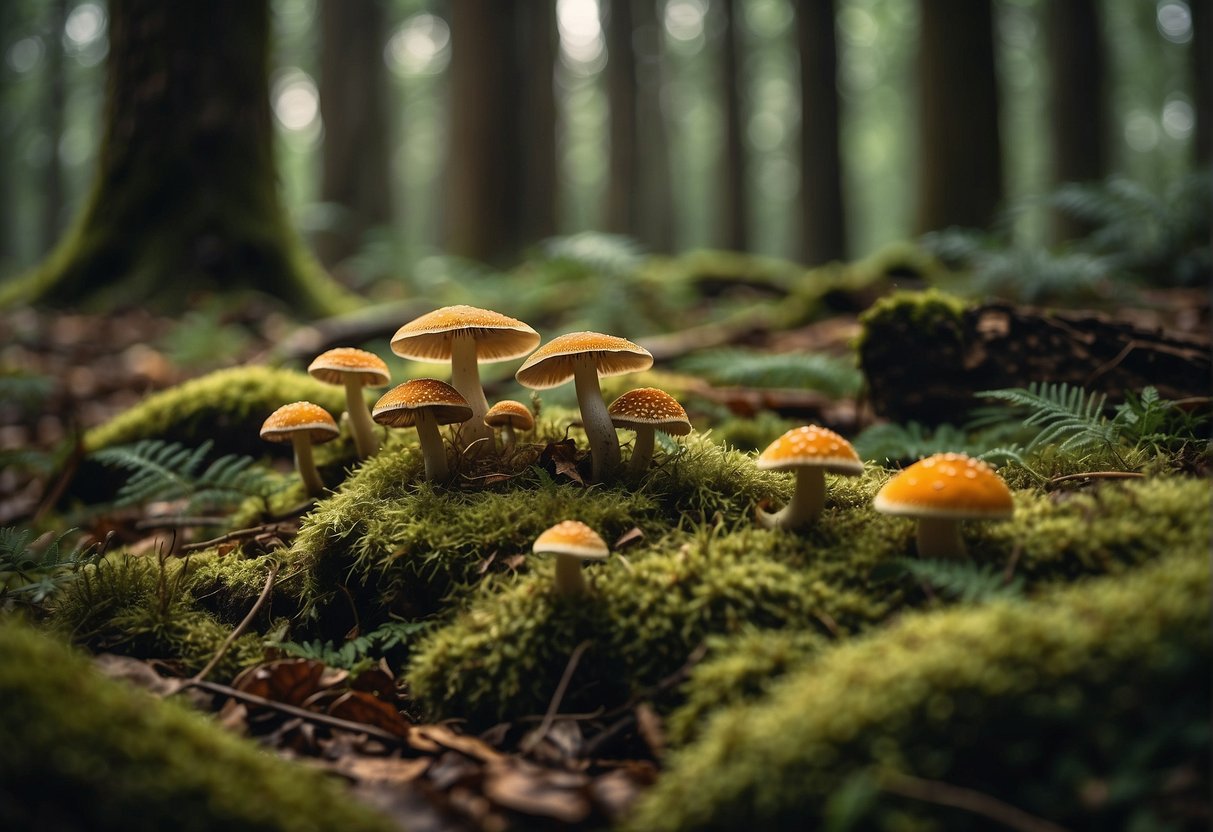
Wild mushrooms have their specific seasons and locales where they are most abundant. Knowing when and where to look can significantly enhance your chances of finding top-quality specimens, whether you’re buying or foraging.
Seasonal Availability
Certain types of wild mushrooms are available during particular seasons in the year. For example, morels emerge in spring, primarily in the United States, following the last frost. In contrast, chanterelles peak in the summer through fall. The sought-after truffles are in their prime time during the winter months, especially in Europe. It is crucial to be mindful of these seasons for the best quality and diversity.
Foraging Regions in North America
Across North America, especially in the Pacific Northwest, including Oregon, and parts of Canada, forests offer rich foraging grounds. During the appropriate seasons, these regions produce an impressive array of wild mushrooms. Burn areas in forests are particularly well-known for their morel mushrooms after a fire has passed through. Always verify with local experts to ensure you’re collecting safe and legal to pick mushrooms.
International Sources
Looking globally, Europe and Asia are also famous for their wild mushrooms. Countries such as Italy and France offer prized truffles, while various regions in Asia provide unique species like shiitake and matsutake. If you’re looking to buy, consider established vendors such as Pacific Rim Mushrooms for a variety of fresh wild mushrooms that can be shipped directly to you.
Purchasing and Storing Wild Mushrooms
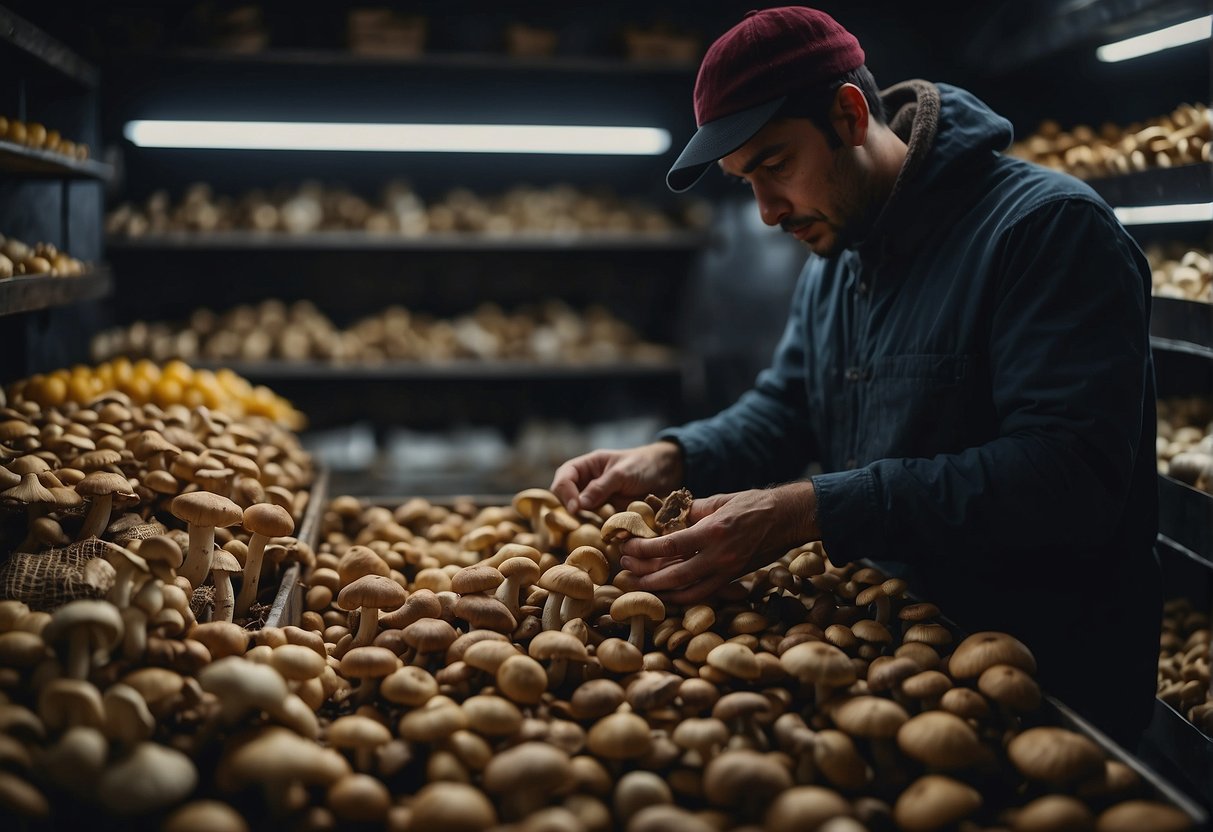
To enjoy the earthy flavors of wild mushrooms, knowing where to buy them and how to store them properly is essential. Ensuring freshness not only maximizes flavor but also extends their shelf life.
Specialty Grocers and Farmers Markets
When looking for fresh wild mushrooms, your local specialty grocers and farmers markets are often the best places to start. These venues typically sell a variety of mushrooms, sourced both locally and regionally. You can speak directly with vendors to learn more about the origins of their mushrooms and how they were harvested. Be sure to check out options like Marx Foods, a reliable source for procuring a diverse range of fresh mushrooms.
Online Vendors and Delivery Options
If you prefer the convenience of shopping from home, there are reputable online vendors that can deliver fresh wild mushrooms right to your doorstep. These range from gourmet food providers to smaller, specialized foragers. Purchasing mushrooms online can provide you access to a wider variety of species that may not be available locally, so you can explore flavors and textures from the comfort of your own kitchen.
Storage Tips to Extend Shelf Life
To maintain the quality of your wild mushrooms and extend their shelf life, proper storage is key:
- In the Refrigerator: Store fresh mushrooms in a paper bag or a breathable container in the refrigerator to keep them fresh.
- Avoid Moisture: Excess moisture can cause mushrooms to become slimy. Check them daily and dry off any condensation that may have formed.
- Use Promptly: Since mushrooms are highly perishable, aim to use them within a few days of purchase. The fresher the mushrooms, the better the flavor and texture in your dishes.
By applying these tips, you’ll ensure your wild mushrooms stay fresh and delicious until you’re ready to use them.
Cooking with Wild Mushrooms
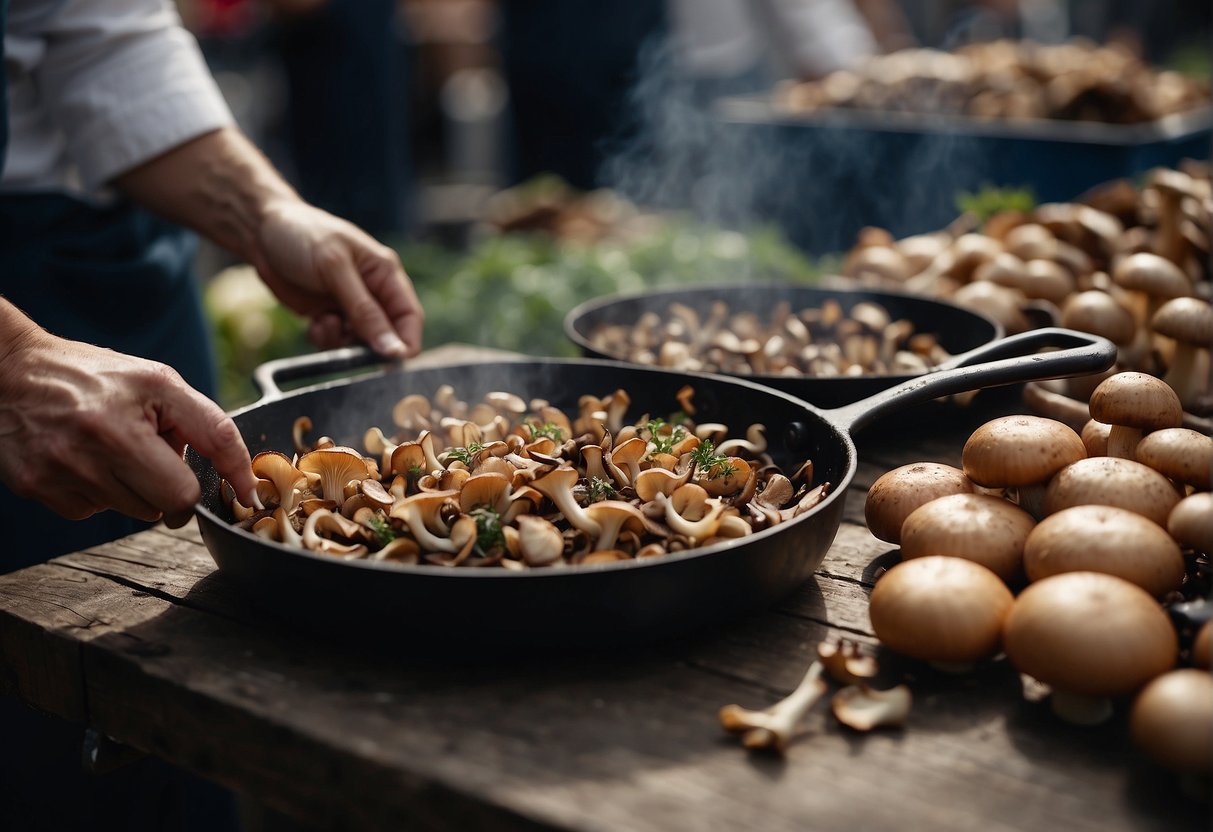
Cooking with wild mushrooms can elevate your outdoor cooking experience by adding rich, earthy flavors to simple dishes. Whether you’re preparing a quick sauté or an elaborate sauce, the right techniques can bring out the best in your foraged finds.
Simple Preparations for Maximum Flavor
When aiming for a pure taste of the wild, minimal cooking is key. Start by cleaning your mushrooms with a brush or a damp cloth to remove any forest debris. Sautéing mushrooms in a bit of butter with shallots and garlic allows their natural flavors to shine through. For a boost of flavor, finish with a sprinkle of fresh herbs. If you’re at camp, cook them in a cast-iron skillet over an open flame for that authentic, smoky taste.
-
Ingredients:
- Wild mushrooms
- Butter
- Shallots
- Garlic
- Fresh herbs (like thyme or parsley)
-
Instructions:
- Clean mushrooms gently.
- Mince shallots and garlic.
- Heat butter in a skillet.
- Sauté shallots and garlic until translucent.
- Add mushrooms and cook until golden.
- Garnish with fresh herbs.
Incorporating Mushrooms into Recipes
Integrating wild mushrooms into your kitchen repertoire can add depth to a variety of dishes. Try making a wild mushroom ragu to top off your pasta, or enhance your soups with sliced varieties like morels or chanterelles. When used as a pizza topping or an appetizer, they bring a taste of the wilderness to the table. Remember to add cheese where applicable, as it complements the fungal flavors wonderfully.
Pairings and Flavor Combinations
Wild mushrooms pair exceptionally well with eggs in a morning scramble or frittata. Incorporate ramps or wild onions for a springtime delicacy. They also make a superb addition to sauces for meats, where their umami qualities can really stand out. For an easy pairing, blend sautéed mushrooms with herbs and use them to stuff meats or as a topping for crostini. Always balance the richness with acidity, such as a dash of balsamic vinegar or a squeeze of lemon.


